最新北师大版小学六年级英语上册(三年级起点)全册教案
2023年最新北师大版六年级英语上册全册教案(含教学反思)

2023年最新北师大版六年级英语上册全册教案(含教学反思)目标 Goals本教案旨在帮助六年级学生研究北师大版英语上册的全部内容,并包含了教学反思。
教学计划 Teaching PlanUnit 1: Greetings- 教学目标:研究问候的表达方式并进行简单的对话。
- 教学内容:问候的礼貌用语,如"Hello, how are you?", "Fine, thank you."等。
- 教学活动:教师以游戏形式呈现问候对话,鼓励学生互相练对话。
Unit 2: Numbers- 教学目标:研究基本的数字表达和数量词的用法。
- 教学内容:英语数字1-100的读法,数量词的用法,如"two books", "three pens"等。
- 教学活动:教师用实例演示数字和数量词的用法,帮助学生进行口语练。
Unit 3: Colors- 教学目标:研究基本的颜色词汇。
- 教学内容:常见颜色的英文表达,如"red", "blue", "green"等。
- 教学活动:教师使用图片和实物展示不同颜色,让学生进行颜色识别和描述。
教学反思 Teaching Reflection通过本教学计划,学生在上述几个单元内研究了基础的英语表达,包括问候、数字和颜色等方面。
教学活动以互动的形式进行,激发了学生的研究兴趣,提高了口语表达能力。
然而,部分学生在数字的读法上还存在一些困难,需要更多的练和巩固。
下一阶段的教学将重点关注数字的训练,并与其他语言技能相结合,帮助学生全面提高英语能力。
以上是2023年最新北师大版六年级英语上册全册教案及教学反思。
教师应根据具体情况进行调整和优化,以达到最好的教学效果。
北师大版六年级上册英语教案5篇2022

北师大版六年级上册英语教案5篇2022教案中对每个课题或每个课时的教学内容,教学步骤的安排,教学方法的选择,板书设计,教具或现代化教学手段的应用,各个教学步骤教学环节的时间分配等等,都要经过周密考虑,精心设计而确定下来,体现着很强的计划性。
以下是小编带来的北师大版六年级上册英语教案内容,感谢您的阅读,希望能帮助到您!北师大版六年级上册英语教案11.—(答案)will you stay in London —Three weeks.A.How oftenB.How muchC.How long2.I’ve got an email in Japanese,(答案)I can’t read it.A.andB.butC.so3.What would you like(答案)A.eatB.eatsC.to eat4.Amy(答案)got a Chinese book.A.isB.hasC.have5.Please don’t wal k(答案)the grass.A.atB.inC.on6.There(答案)some birds in the tree.A.isB.areC.be7.—(答案)is New York —It’s here, in the street.A.WhatB.WhereC.Who8.Have you got(答案)stamps from CanadaA.someB.anyC.a9.All letters(答案)from China.A.beB.isC.are10.Mr Zhang is very friendly, and(答案)like him very much.B.weC.our北师大版六年级上册英语教案2《Meet my family》教学目标:新课程强调知识与技能、过程与方法、情感态度与价值观三个角度的有机结合,本着这样的认识,我制定如下教学目标。
认知目标学生能听、说、读短语及单词:family,parents,aunt,uncle,babybrother能运用 how many......进行口语交际。
新教材北师大版三起六年级英语上册全册教案第一学期全套教学设计

新教材北师大版三起六年级英语上册全册教案第一学期全套教学设计UNIT One Ann’s dream新课标体现:本单元主要是要求学生能够用过去时表达过去发生的一些事情,能够用本单元主要句式询问对方或他人在过去时间的住所。
让学生对一般过去时有一个初步的认识。
引导学生形成与人为善的态度。
本单元能够丰富学生的天文知识,激发学生乐于观察的热情。
导学目标:知识技能:1、Listening:能够理解本单元的故事。
2、Speaking:能用过去时简单的描述在过去发生的事情,能用本单元主要句式询问对方或他人在过去时间的住所。
3、Reading:能正确、流利的朗读课文和一些辅音的读法。
4、Writing:能正确、规范地拼写本单元要求掌握的生词和短语;能听写本单元功能句,并做出应答。
过程方法:1、利用现有的教设备资源,使学生可以更加直观的对所要学习的内容有整体了解,并且可以培养学生良好的发音习惯,为以后的学习打下基础。
2、在教授对话的同时,把单词或重点句型出示给学生,这样可以使学生更方便于学习,掌握,和运用。
3、在教学时多采取同学之间互相帮助的功能,可以加深同学之间的感情,还可以帮助班主任更好的完成思想道德教育工作。
教学重点:1.Where are you from? 及回答.2.Where were you yesterday afternoon? I was at home.3.过去时was, were, had 的表达教学难点:1.过去时的用法及表达。
2.如何用过去时描述自己的梦和过去所在的场所。
3.一些单词的记忆。
单元第课(章)第课时总第课时课题Ann’s dream 课型New 主备人导学目标:1. The students can describe the picture.2. The students like to learn English.3. The students can be writing and reading.教学重点:1.How can use “had, was, were” in dialogue.Answer it.教学难点1. How to use past tense.2. Emphasis new words.导学过程:Step1:T: Introduce myself and let student introduce themselves (name, age, hobby and so on) (困)S: Introduce themselves about name, age etc.Step2:To review what has been learned last semester.Step3:Set the sceneT: Let the children talk about what they did during the summer vacation. Ask some questions: Where you went? Whoyou saw? What you did?Let them share their experience with each other.S: Try to answer the questions.T: Ask the children the question, “Where were you?”S: Try to answer the question.Step4:Get preparedT: Ask children if they had any dream at night these days. Let them talk about their dreams.S: Try to talk about their dreamsT: let them read about Ann’s dream.S: Read Ann’s dream.T: To describe what illustrated in each picture and the main plot is.S: Listen and think.T: Play the tape for the story.S: Listen to the tape. (困)Step5:Tell the storyT: Have the children look at the pictures .The teacher tells the story to the children. S: Listen and look at the picture.T: Have the children read the text by themselves.S: Read the text.T: Listen to the tape. Play the tape again. Ask some questions.Who had a dream?Who were in her dream?Where were they?Where were they now?Was it cold on Mars?Were there Martians on Mars? How do you think Ken andAnn fell?Were the Martians friendly?S: Try to answer the questions.Step6:Homework: Have the children create their own image of Martians.Blackboard writing:Ann had a dream last night.She and Ken were in her dream.They were in the space.They were on Mars.It was very cold on Mars.There were Martians on Mars. Ken and Ann were afraid.Yes, the Martians were friendly.第单元第课(章)第课时总第课时课题Ann’s dream 课型New 主备人导学目标:1. The students can describe the picture.2. The students like to learn English.3. The students can be writing and reading.教学重点:1. How can use “had, was, were” in dialogue. Answer it.教学难点1. How to use past tense.2. Emphasis new words.导学过程:Step1:Review :( plays a game)T: Take a card and hide it. I had a dream last night. In my dream I was…S: Guess it.Step2:Learn the new words.T: Have the children open their books at page4. Draw their attention to the top half of the page. Point to the picture and ask: “What can you see in the picture?”S: Open the book and answer the question.T: Model the word and have the children repeat. Use the same procedure with the other words in the picture.S: Read the words after the teacher.T: Let student read the words again.S: read the words.T: Let students listen to the tape and point the new wordsS: listen and point. Repeat after the tape. 困Step3:Listen and number.T: Have the children look at the pictures at the bottom of the page. Explain that each of the pictures describes a different dream of Ann.S: Look at the picture.T: Let the children talk about where Ann was and what she was in each dream.S: Answer it.T: Play the tape. Let the children point the picture.S: Listen to the tape and point the picture.T: Play the tape again. Let children write the corresponding sentence number in the box next to the matching picture.S: listen and match.T: Point to each picture and elicit sentences from the children.Step4:Talk togetherT: Have the children open the books at page 5 and look at the picture on top of the page.S: Open the books look at the picture.T: Explain that Sue and Peter are talking about where they were yesterday. Ask the children where they think Sue and Peter were yesterday.S: Answer the question.T: Read the text and ask the children repeat.S: Listen and repeat.T: Pair works. For example, where was Ann yesterday? She was at the swimming pool.S: Practice the dialog.Step5:Listen and practice.T: Draw their attention to the picture at the bottom of the page. Have them talk about the picture and then practice reading the sentence by them.S: Talk about the picture.T: Play the tape and let student read after the tape.S: Listen and read. 困Step6:Homework: Read the story.Blackboard writing:Dream, Last night, air, afraid, yesterday, were, was, had, space, a spaceship, a space suit, an astronaut, a planet, the moon, stars.第单元第课(章)第课时总第课时课题Ann’s dream 课型New 主备人导学目标:1. The students can tell the story.2. The students like to learn English.3. The students can be writing and speaking.教学重点:1. How can us e “had, was, were” to make sentences.教学难点1. How to use past tense.2. How to tell the story..导学过程:Step1:Review the story.T: Point to each picture, elicit the story from the children. Point to the first picture and say, “In this picture, Ann had a…” Elicit from the children Ann had a dream. Repeat with other pictures and highlight the sentences They were on Mars. They were in a spaceship.S: Follow the teacher and retell the story.T: Ask the questions, “Where were you yesterday?”S: I was at school. I was at home. I had an English class etc.T: write the sentences on the blackboard and let the children read each sentences.S: Read the sentences after the teacher.Step2:Uncle Booky’s BlackboardT: Tell the children to look at the blackboard on the top of page 6. Model the structures by reading them aloud to the class.S: Listen and think. 困T: Have the children repeat the structures in a class drill. Use all possible combinations.S: Repeat the structures.T: Explain that we use was/were to describe things thathappened in the past. Give an example, He was in Shanghai yesterday. He is in Beijing now.S: Make the sentences by themselves.Step3:Touch and say.T: Let the children look at the pictures at the bottom of the page. Let them tell the Mocky’s dream and that they only to say one sentence for each picture.S: Try to tell the dream.T: Ask some questions, “Who were in Mocky’s dream? Where were they?S: Try to answer the questions.T: Point to the picture and elicit descriptions from the children.S: Try to describe the pictures.Step4:Read and write.T: Have the children open the books at page 7. Explain to the children that the letter was written by a girl called Jane. Have them complete the letter.S: Try to complete the letter.T: If the children cannot do it, discuss with your partner.S: Do it and discuss.T: Let the children read the letter together.S: Read the letter.T: Have the children write about Uncle Booky’s dream.S: Try to write it by them. 困Step5:Tell the dream.T: Have the children to tell each other their dreams like twochildren on the book. Put them into pairs and practice.S: Try to tell the dream about them.Step6:Homework: Tell the dream to their parents.Blackboard writing:I was at home. We were at home.I was at school. We were at school.I had an English class. We had an English class.第单元第课(章)第课时总第课时课题Ann’s dream 课型New 主备人导学目标:1. The students can read the special sounds.2. The students like to learn English.3. The students can be listening and match.教学重点:1. How to pronounce the special sounds教学难点1. How to pronounce the special sounds.2. Listening and match and interview the students..导学过程:Step1:Special sounds.T: Have the children look at the pictures and try to read the words.S: Look at the picture and try to read.T: Play the tape and have the children repeat.S: Listen and repeat.Step2:Decode the messageT: Have the children open the book and ask them if they canread the message.S: Look at the message.T: Have the children look at the code and ask the children to decipher the message by themselves.S: Decipher the message.Step3:Write the messageT: Have the children write the message to the Martians.S: Write the message.T: Have the children pair work (They give their message to each other and decode the message)S: Decode the message.Step4:Listen and match.T: Have the children look at the pictures on top of page9.S: Open the books.T: Have the children talk about the pictures.S: Talk about the pictures.T: Play the tape and have the children listen and match.(困)S: Listen to the tape and match.(困)T: Have the children tell the teacher the name of the children was in the pictures. Step5:Ask and find out.T: Have the children look at the pictures at the bottom of the page.S: Look at the picturesT: Have the children interview the other students for where they were yesterday. S: Interview and write the sentences on the book.When they finished have them report their findings.Homework:Write the message to the Martians.第单元第课(章)第课时总第课时课题Ann’s dream 课型New 主备人导学目标:1. The students can read the story.2. The students like to learn English.3. The students can be listening and match.教学重点:1. How to read the story and choose the right answer教学难点1. How to read the story.2. How to answer the questions and write the words导学过程:Step1:Review the Ann’s dreamT: Have the children try to retell the Ann’s dream.S: Try to retell.T: Have the children retell the dream together.S: Do it.Step2:T: Have the children try to read Lane’s dream, and try to write the missing words. S: Read the Lane’s dream and try to write the missing words.T: Have the children try to read the dream and check the answer.S: Check the answer.Step3:T: Have the children write the Uncle Booky’s dream.S: Try to write it.困T: Review Ann’s dream with children.S: Retell the dream.T: Have the children write three sentences about Ann’s dream.S: Try to do it.Step4:ReflectionT: Explain some sentences to the children.S: Open the books and look at the sentences.T: Have the children read the sentences and try to do it.S: Read the sentences and write the answer about this unit.T: Have the children do the group work.S: Group work and finish the reflection.Homework:Review Ann’s dream.Homework: H ave the children write Ann’s dream.UNIT twoMocky’s bad day新课标体现:本单元主要是要求学生能够用过去时表达过去发生的一些事情,能够用本单元主要句式询问对方或他人在过去时间在干什么。
六年级英语上册Unit3Sports教案北师大版(三起)
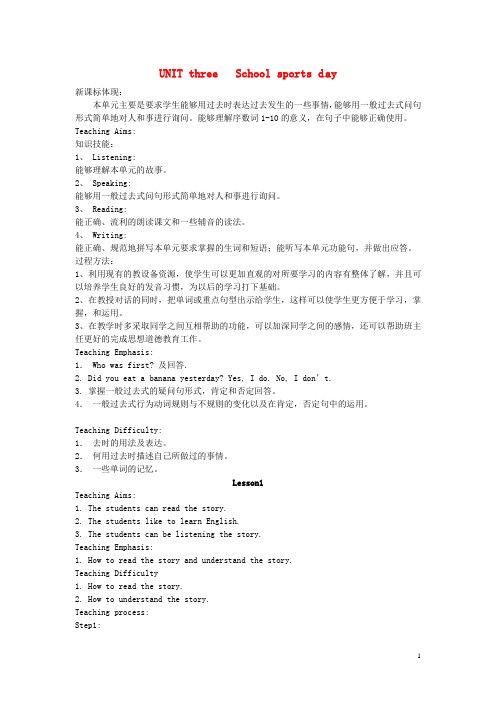
UNIT three School sports day新课标体现:本单元主要是要求学生能够用过去时表达过去发生的一些事情,能够用一般过去式问句形式简单地对人和事进行询问。
能够理解序数词1-10的意义,在句子中能够正确使用。
Teaching Aims:知识技能:1、 Listening:能够理解本单元的故事。
2、 Speaking:能够用一般过去式问句形式简单地对人和事进行询问。
3、 Reading:能正确、流利的朗读课文和一些辅音的读法。
4、 Writing:能正确、规范地拼写本单元要求掌握的生词和短语;能听写本单元功能句,并做出应答。
过程方法:1、利用现有的教设备资源,使学生可以更加直观的对所要学习的内容有整体了解,并且可以培养学生良好的发音习惯,为以后的学习打下基础。
2、在教授对话的同时,把单词或重点句型出示给学生,这样可以使学生更方便于学习,掌握,和运用。
3、在教学时多采取同学之间互相帮助的功能,可以加深同学之间的感情,还可以帮助班主任更好的完成思想道德教育工作。
Teaching Emphasis:1. Who was first? 及回答.2. Did you eat a banana yesterday? Yes, I do. No, I don’t.3. 掌握一般过去式的疑问句形式,肯定和否定回答。
4.一般过去式行为动词规则与不规则的变化以及在肯定,否定句中的运用。
Teaching Difficulty:1.去时的用法及表达。
2.何用过去时描述自己所做过的事情。
3.一些单词的记忆。
Lesson1Teaching Aims:1. The students can read the story.2. The students like to learn English.3. The students can be listening the story.Teaching Emphasis:1. How to read the story and understand the story.Teaching Difficulty1. How to read the story.2. How to understand the story.Teaching process:Step1:Review all the verbs learned so far.T: Have the children look at the TV about the past words.S: Look at the TV and remember the words.T: Have the children look at the flashcards for Unit1 and 2.S: Look at the flashcards.Step2:Set the sceneT: Ask the children to talk about the sports day they had this year.S: Try to talk about the sports.T: Present the words race, won a prize, first, second, third. Ask one student: Did you run?S: Answer the question. Yes, I do. No, I don’t.T: Have the children read the sentences after the teacher.S: Read the sentences after the teacher.Step3:Get preparedT: Tell the children they are going to read about the sports day at Ken and Ann’s school. Have them open the books and read the story first. Then ask them to say what the story is about.S: Open the books and try to read the story and try to talk about the story. T: Play the tape and have the children listen to the tape.S: Listen to the tape.T: Play the tape again and have the children read after the tape.S: Listen and repeat.Step4:Tell the storyT: Have the children pay attention to the text at the bottom of the pages. Explain that the text tells more about the story. Have the children read the story.S: Try to read the story by themselves.T: Have the children try to talk about the story.S: Try to talk about the story.T: Have the children look at the picture and tell the story to them.S: Look a t the picture and listen.T: Play the tape and have the children listen to the tape.S: Listen to the tape.T: Play the tape again and ask some questions.1. What do you think Ken is going to do?2. Do you think Ken is running well?3. Did Ken win the race?4. Did Ann win the race?5. Is Mocky look happy?6. Did Mocky win a prize?S: Try to answer the questions.T: Have the children talk about the sports day.S: Try to talk about.Homework:Copy the new words four times.课后反思:学生的兴趣浓厚,对故事很感兴趣,并能够根据图片内容复述课文。
北师大版六年级英语上全册教案

小学六年级上学期英语教学设计小学英语六年级(上学期)全册备课对新课标理解:现在社会是向着全球化,社会化发展,将来地球不管是哪一个角落都是一我们地球林一个村民,那么语言就成了一个统一交流媒介,尤其是英语重要性在这一进程中日益突出。
本次对于课程标准重新更定是一次符合社会发展进程和基础教育进程改革。
重点是要改革英语课程教学,过分重视语法和词汇知识讲解及传授,忽视对学生实际语言运用能力培养倾向,强调课程应从学生学习兴趣、生活体验和认知水平出,倡导学生体验、实践、参及、合作及交流学习方式和任务型必学途径,发展学生综合语言运用能力,使语言学习过程成为学生形成积极情感态度,主动思维和大胆实践,提高跨文化意识和形成自主学习能力过程。
做到这些要求,首先需要就是学生浓厚对英语学习兴趣,那怎么样培养学生学习兴趣就成了一个基础话题,这一问题要面向全体学生,特别是要关注学生个别差异引起情感问题。
帮助学生建立成就感和自信心。
在教学中注意创设能引导学生主动参及教学环境,激发学生学习积极性。
使每个学生都能得到充分发展。
在这一过程中教学模式转变起到了一定作用,一定要从以老师为中心教学模式身以学生为中心教学模式转变。
强调学生参及和体验,强调采用多种形式教学活动。
比如可以利用我们学校已有良好电教资源,听原版录音带练习发音,也可以利用网络找一些贴近课堂学习情境对话或小动画,以更直接方式引导学生学习英语,对英语产生浓厚兴趣。
利用听、说促进学生写单词,写短语,写句子,写对话,不能反其道而行,又造成以往我们说“哑吧英语”。
总来说,新课标对发展学生自我主观能动性起到了很积极作用。
素质教育在其中深有体现。
并且由升学教育向终身教育转变等等都是很好突破。
在这一新课标指导下,希望在英语教学中可以达到更好效果。
Teaching contents:本册书共六个单元,其中五个单元是精读课文,一个复习单元,而且每个单元都有听、说、读、写等多项练习。
书后有分类清晰词汇表,更有利于教师教和学生学。
北师大版六年级英语上全册教案

北师大版六年级英语上全册教案
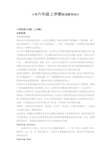
小学六年级上学期英语教学设计小学英语六年级(上学期)全册备课对新课标理解:现在的社会是向着全球化,社会化发展的,将来的地球不管是哪一个角落都是一我们地球林的一个村民,那么语言就成了一个统一交流的媒介,尤其是英语的重要性在这一进程中日益突出。
本次对于课程标准的重新更定是一次符合社会发展进程和基础教育进程的改革。
重点是要改革英语课程的教学,过分重视语法和词汇知识的讲解与传授,忽视对学生实际语言运用能力的培养倾向,强调课程应从学生的学习兴趣、生活体验和认知水平出,倡导学生体验、实践、参与、合作与交流的学习方式和任务型的必学途径,发展学生的综合语言运用能力,使语言学习的过程成为学生形成积极的情感态度,主动思维和大胆实践,提高跨文化意识和形成自主学习能力的过程。
做到这些要求,首先需要的就是学生浓厚的对英语学习的兴趣,那怎么样培养学生学习兴趣就成了一个基础话题,这一问题要面向全体学生,特别是要关注学生的个别差异引起的情感问题。
帮助学生建立成就感和自信心。
在教学中注意创设能引导学生主动参与的教学环境,激发学生的学习积极性。
使每个学生都能得到充分的发展。
在这一过程中教学模式的转变起到了一定的作用,一定要从以老师为中心的教学模式身以学生为中心的教学模式转变。
强调学生的参与和体验,强调采用多种形式的教学活动。
比如可以利用我们学校已有的良好电教资源,听原版录音带练习发音,也可以利用网络找一些贴近课堂学习的情境对话或小动画,以更直接的方式引导学生学习英语,对英语产生浓厚的兴趣。
利用听、说促进学生写单词,写短语,写句子,写对话,不能反其道而行,又造成以往我们说的“哑吧英语”。
总的来说,新课标对发展学生自我主观能动性起到了很积极的作用。
素质教育在其中深有体现。
并且由升学教育向终身教育的转变等等都是很好的突破。
在这一新课标的指导下,希望在英语教学中可以达到更好的效果。
Teaching contents:本册书共六个单元,其中五个单元是精读课文,一个复习单元,而且每个单元都有听、说、读、写等多项练习。
北师大版三年级起点小学六年级英语上册教案Unit 5 Height and Weight_教案6

Unit5 Height and WeightLesson 6 Round Up【教学目标】1.询问、说明身高和体重。
2.和别人比较身高和体重。
3.结合插图,了解几项世界之最。
4.读懂Uncle Booky’s Storytime 小故事。
【教学重难点】复习本单元所学主要内容。
【教学准备】课件、音频(教师可以在平台直接调用或下载)。
【教学过程】I.Get Ready1.准备几张动物的照片,结合照片引导学生说—说动物之最,例如最重的、最长寿的动物等。
2.呈现故事插图,引导学生讲述故事。
II.Read and Complete1.让学生看页面上部的表格,给学生解释需要他们根据提示完成表格。
2.给学生时间独立完成。
3.让学生找一找本单元还出现了哪些形容词,补充表格的内容。
III.Group the Words1.让学生观察完成表格中形容词变化的特点,说一说变化的规律。
2.让学生根据发现的规律.给这些形容词分组。
3.让学生说一说他们分组的情况,全班一起核对答案。
IV.Read and Write1.告诉学生接下来需要他们填写有关个人情况的信息,让学生看页面上的表,给学生时间独立完成。
2.让学生根据表格信息采访一位同学,并做记录。
3.让学生比较自己和所采访的同学,比一比身高、年龄、体重等,然后根据提示写出相应的句子。
4.让学生读出他们写的句子。
V.Fact File1.让学生看页面上的照片,根据文字说明说一说这些照片显示的什么内容。
2.教师朗读照片的说明文字,结合照片做相应的说明或解释。
3.让学生说出他们还知道哪些世界之最,鼓励学生用英语说一说。
VI.Self-assessment1.让学生回顾本单元所学的内容,根据评价表上的项目,对个人学习情况做出评价。
2.可以采用师生问答的方式,引导学生说一说对某些项目的回答。
结合学生的回答,教师提供方法指导。
VII.Uncle Booky's Storytime1.让学生浏览插图,说一说这是什么故事。
北师大版小学六年级英语上册教案5篇

北师大版小学六年级英语上册教案5篇北师大版小学六年级英语上册教案1教学目标:1. 能正确的听、说、读、写词汇holiday, last, early, meet, before能正确的听,说,读词汇 fun, National Day, a film, wonderful2. 能正确的听、说、句型What (else) did you do??We/I?3. 能正确地运用对话中的日常交际用语和三会句型 Did you like the film?It was a funny cartoon. We all liked it very much.. Were there any fruit trees on the farm? There were apple trees, orange trees and pear trees.4. 能正确地理解、掌握对话内容,并能朗读、初步表演对话。
5. 能运用本课所学语言谈论过去所做的事情。
教学重点:能正确地理解、掌握对话内容,并能朗读、初步表演对话。
教学难点:能比较流畅的朗读对话,并能在掌握对话的基础上运用本课所学语言谈论过去所做的事情。
课前准备:1.教具准备a.单词,句型卡片。
b.练习题纸。
(每人一张)c.设计并制作多媒体教学课件,准备多媒体教学的设施。
2.板书准备预先写好课题Unit 5 On the farm教学过程:Step 1 Greeting and warming-up1. T-Ss greet.(师生问好,活跃课堂,拉近师生距离)2. T: Look at this man, what’s his job?Ss: He is a farmer.T: His name is Macdonald. He has a beautiful farm.Before class, let’s listen to a song, it’s about Macdonald and his farm.Step 2 Presentation and practice1. Teach: National Day ,holiday, lastT: What day/date is it today?出示CAI指名回答 These seven days is this week.(CAI出示 this week) These seven days was last week.( CAI出示 last week)T: What date was it? 指名回答T: Yes. It was the first of October.And it was the National Day. (CAI出示National Day领读)When National Day comes ,we usually have a long holiday . I had a wonderful holiday.2 .T:Do you want to know what I did this National Day holiday?You can ask me what did you do?指名几个学生提问,可提醒学生看黑板上早已贴好的句子。
北师大版小学六年级英语上册教案.doc
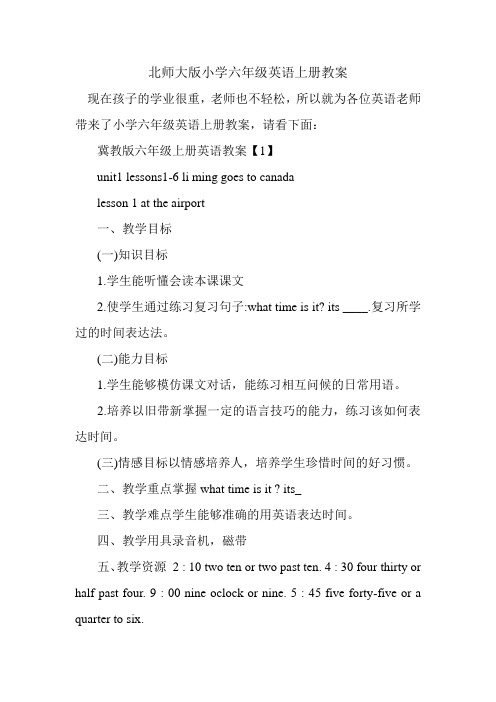
北师大版小学六年级英语上册教案现在孩子的学业很重,老师也不轻松,所以就为各位英语老师带来了小学六年级英语上册教案,请看下面:冀教版六年级上册英语教案【1】unit1 lessons1-6 li ming goes to canadalesson 1 at the airport一、教学目标(一)知识目标1.学生能听懂会读本课课文2.使学生通过练习复习句子:what time is it? its ____.复习所学过的时间表达法。
(二)能力目标1.学生能够模仿课文对话,能练习相互问候的日常用语。
2.培养以旧带新掌握一定的语言技巧的能力,练习该如何表达时间。
(三)情感目标以情感培养人,培养学生珍惜时间的好习惯。
二、教学重点掌握what time is it ? its_三、教学难点学生能够准确的用英语表达时间。
四、教学用具录音机,磁带五、教学资源2 : 10 two ten or two past ten. 4 : 30 four thirty or half past four. 9 : 00 nine oclock or nine. 5 : 45 five forty-five or a quarter to six.六、教学过程:step 1 : review1) play a game: “ the number game” to review number , play with numbers up to ten thousand .2) review some phrases : what day is it ? what time is it ?step 2 : presentation and practice1.引出新课题,教授新单词airport,教读数遍并让学生明白单词的意思。
2.ask and answer:1).who is this? jenny\danny\li ming.2).where does jenny live? canada. where does li ming live? china.3)how long is it from september 1 to june 25? ss count the months: october november december january februaryjune. wow! thats ten months.3.teaching “ what time is it ? ”1) 指着自己的手腕处,ask: what time is it ? (强调连读is it).explain that we use “oclock” only on the hour.2) demonstrate : draw a clock on the blackboard. more the hands on the clock as t asks and answer the question . then get volunteers to answer the question . eg: 2:40 two forty 5:10 five ten 6:37 six thirty seven 9:00 nine oclock 3.practice :1) practice in pairs .2)ask the volunteers to more the hands on the clock as they ask and answer the question .4.teaching “ the text ”1)when the students listen to the tape , think over the question :a.why does liming come to canada ?b.when does li ming arrive ? when will liming go home?c.what time did li mings plane arrive ?d.who meets him at the airport ?e.did he have a good trip ?2)read the dialogue and discuss the questions in groups .3)ask the students to answer the questions .4)read by themselves , then read role-play .step 3.homeworkmake up a dialogue about meeting someone at the airport . use“ what time is it ? its .”七、blackboardlesson 1 at the airport5 oclock --what time is it?6 oclock --its 5:25.lesson2 jennys house一、教学目标:(一)知识目标:1、能听、说、读、写单词:bedroom; kitchen; bathroom; living room ,toilet ,study2、能用英语简单描述自己的家中的各个房间。
北师大小学三起点英语六年级上册Unit1_第3课时教学设计
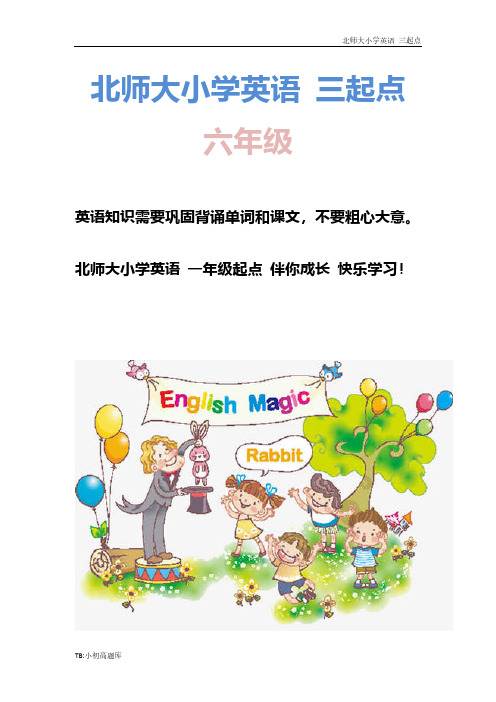
北师大小学英语三起点六年级英语知识需要巩固背诵单词和课文,不要粗心大意。
北师大小学英语一年级起点伴你成长快乐学习!Unit1 第3课时教学设计教学目标在本课结束时,学生能:1. 在情景中询问和说明过去某时在哪里;2. 听懂、模仿关于说明过去某时某人在哪里的对话;3. 在图片的提示下,表演、讲述故事主要情节或内容;4. 归纳故事中的出现的一般过去时结构。
教学重点1. 在插图的提示下讲故事;2. 在对话中运用所学句型,询问或说明过去某时某人在哪里。
教学难点在插图的帮助下讲述故事的主要内容。
教学准备课件、音频(教师可以在优教平台直接调用或下载)。
教学建议Warm up(1) 演唱本单元歌曲。
(2) 采用教师提问的方式,和学生交流他们昨晚或上周末在哪里。
T:Where were you last night/last weekend? Did you have a good time?Listen and Number(1) 让学生看插图,引导学生说一说图中的人物分别是谁、他们在哪里。
(2) 完整播放一遍录音,学生根据听力内容给插图标上序号。
(3) 再次播放录音,核对完成情况。
可以教师提问,让学生根据录音内容回答。
(4) 播放录音,可以让学生跟读。
(5) 可以引导学生说一说是否做过有关职业的梦。
T:Did you have a dream about jobs? When did you have the dream? What were you in the dream?Talk Together1. 呈现情景(1) 告诉学生接下来看两位小朋友昨天下午在哪里。
(2) 让学生看右边情景图,说一说里面都有哪些场所、建筑或设施,猜一猜两位小朋友昨天下午可能在哪里。
2. 学习对话(1) 让学生看对话,先说一说对话的两个小朋友叫什么。
(2) 让学生听对话,然后说一说:Jack昨天下午在哪里。
(3) 播放对话录音,可以让学生跟读、朗读。
北师大小学三起点英语六年级上册Unit1_第1课时教学设计
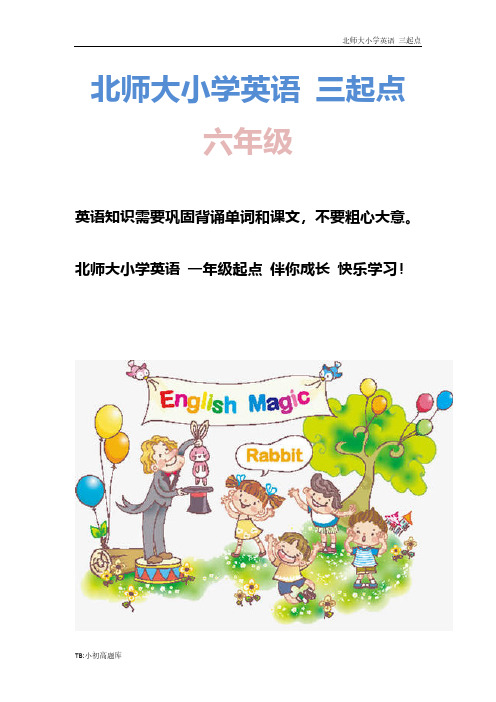
北师大小学英语三起点六年级英语知识需要巩固背诵单词和课文,不要粗心大意。
北师大小学英语一年级起点伴你成长快乐学习!Unit1 第1课时教学设计教学目标在本课结束时,学生能:1. 在插图的帮助下,读懂故事内容,理解叙述文本;2. 在教师的帮助和插图的提示下分角色表演故事,讲述故事的主要情节;3. 意识到在讲述过去发生的事情时,语句中的动词会发生变化;4. 通过学习故事内容,展开想象,激发了解太空知识的兴趣和愿望。
教学重点1. 结合插图理解故事主要情节,读懂叙述,本内容;2. 初步感知和理解一般过去时态的用法和意义。
教学难点理解在讲述过去发生的动作或状态时,句子中的am/is, are等要发生变化。
教具准备课件、音频(教师可以在优教平台直接调用或下载)。
教学建议Get Ready1. 引入话题(1) 引导学生说一说他们所知道的太空知识。
T:What do you know about space?(2) 呈现space图,让学生说一说有关太空的词汇。
2. 学习相关词汇(1) 出示astronaut不完整的图片,让学生观察、猜测,学习astronaut.(2) 利用其他的图片呈现有关太空的词汇,如:in space, in a spaceship等。
3. 说明图片内容(1) 引导学生看图猜测,说一说图中的人物有可能正在说什么。
T:What are they talking about?(2) 说明图中的儿童正在交流自己做的梦。
结合插图引导学生理解dream,last night等情景词汇。
(3) 假设图片是对话人物的梦境,引导学生套用对话,说一说他们梦到了什么。
例如I had a dream last night. I was on the moon.(4) 可以鼓励学生说一说他们自己梦到了什么。
Enjoy the Story1. 导入故事结合对话内容,让学生猜一猜Arm和Ken梦到什么内容。
2. 学习故事I. 师生问答,分享故事(1) 呈现图1,引导学生说一说Ann在给Ken和Mocky讲述什么。
最新北师大版小学英语六年级上学期教案备课-优质教案
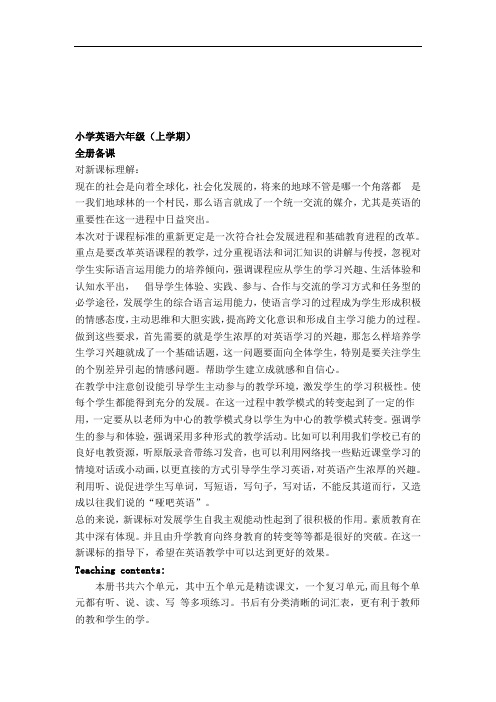
小学英语六年级(上学期)全册备课对新课标理解:现在的社会是向着全球化,社会化发展的,将来的地球不管是哪一个角落都是一我们地球林的一个村民,那么语言就成了一个统一交流的媒介,尤其是英语的重要性在这一进程中日益突出。
本次对于课程标准的重新更定是一次符合社会发展进程和基础教育进程的改革。
重点是要改革英语课程的教学,过分重视语法和词汇知识的讲解与传授,忽视对学生实际语言运用能力的培养倾向,强调课程应从学生的学习兴趣、生活体验和认知水平出,倡导学生体验、实践、参与、合作与交流的学习方式和任务型的必学途径,发展学生的综合语言运用能力,使语言学习的过程成为学生形成积极的情感态度,主动思维和大胆实践,提高跨文化意识和形成自主学习能力的过程。
做到这些要求,首先需要的就是学生浓厚的对英语学习的兴趣,那怎么样培养学生学习兴趣就成了一个基础话题,这一问题要面向全体学生,特别是要关注学生的个别差异引起的情感问题。
帮助学生建立成就感和自信心。
在教学中注意创设能引导学生主动参与的教学环境,激发学生的学习积极性。
使每个学生都能得到充分的发展。
在这一过程中教学模式的转变起到了一定的作用,一定要从以老师为中心的教学模式身以学生为中心的教学模式转变。
强调学生的参与和体验,强调采用多种形式的教学活动。
比如可以利用我们学校已有的良好电教资源,听原版录音带练习发音,也可以利用网络找一些贴近课堂学习的情境对话或小动画,以更直接的方式引导学生学习英语,对英语产生浓厚的兴趣。
利用听、说促进学生写单词,写短语,写句子,写对话,不能反其道而行,又造成以往我们说的“哑吧英语”。
总的来说,新课标对发展学生自我主观能动性起到了很积极的作用。
素质教育在其中深有体现。
并且由升学教育向终身教育的转变等等都是很好的突破。
在这一新课标的指导下,希望在英语教学中可以达到更好的效果。
Teaching contents:本册书共六个单元,其中五个单元是精读课文,一个复习单元,而且每个单元都有听、说、读、写等多项练习。
北师大版小学六英语年语{上册)全套教案设计
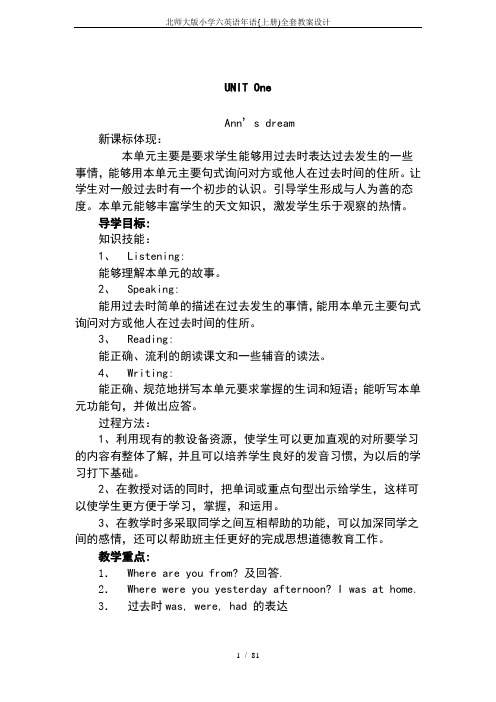
UNIT OneAnn’s dream新课标体现:本单元主要是要求学生能够用过去时表达过去发生的一些事情,能够用本单元主要句式询问对方或他人在过去时间的住所。
让学生对一般过去时有一个初步的认识。
引导学生形成与人为善的态度。
本单元能够丰富学生的天文知识,激发学生乐于观察的热情。
导学目标:知识技能:1、Listening:能够理解本单元的故事。
2、Speaking:能用过去时简单的描述在过去发生的事情,能用本单元主要句式询问对方或他人在过去时间的住所。
3、Reading:能正确、流利的朗读课文和一些辅音的读法。
4、Writing:能正确、规范地拼写本单元要求掌握的生词和短语;能听写本单元功能句,并做出应答。
过程方法:1、利用现有的教设备资源,使学生可以更加直观的对所要学习的内容有整体了解,并且可以培养学生良好的发音习惯,为以后的学习打下基础。
2、在教授对话的同时,把单词或重点句型出示给学生,这样可以使学生更方便于学习,掌握,和运用。
3、在教学时多采取同学之间互相帮助的功能,可以加深同学之间的感情,还可以帮助班主任更好的完成思想道德教育工作。
教学重点:1.Where are you from? 及回答.2.Where were you yesterday afternoon? I was at home.3.过去时was, were, had 的表达教学难点:1.过去时的用法及表达。
2.如何用过去时描述自己的梦和过去所在的场所。
3.一些单词的记忆。
第单元第课(章)第课时总第课时课题 Ann’s dream 课型 New 主备人导学目标:1. The students can describe the picture.2. The students like to learn English.3. The students can be writing and reading.教学重点:1.How can use “had, was, were” in dialogue.Answer it.教学难点1. How to use past tense.2. Emphasis new words.导学过程:Step1:T: Introduce myself and let student introduce themselves (name, age, hobby and so on) (困)S: Introduce themselves about name, age etc.Step2:To review what has been learned last semester.Step3:Set the sceneT: Let the children talk about what they did during the summer vacation. Ask some questions: Where you went? Who you saw? What you did?Let them share their experience with each other.S: Try to answer the questions.T: Ask the children the question, “Where were you?”S: Try to answer the question.Step4:Get preparedT: Ask children if they had any dream at night these days. Let them talk about their dreams.S: Try to talk about their dreamsT: let them read about Ann’s dream.S: Read Ann’s dream.T: To describe what illustrated in each picture and the main plot is.S: Listen and think.T: Play the tape for the story.S: Listen to the tape. (困)Step5:Tell the storyT: Have the children look at the pictures .The teacher tells the story to the children.S: Listen and look at the picture.T: Have the children read the text by themselves.S: Read the text.T: Listen to the tape. Play the tape again. Ask some questions.Who had a dream?Who were in her dream?Where were they?Where were they now?Was it cold on Mars?Were there Martians on Mars? How do you think Ken and Ann fell?Were the Martians friendly?S: Try to answer the questions.Step6:Homework: Have the children create their own image of Martians.Blackboard writing:Ann had a dream last night.She and Ken were in her dream.They were in the space.They were on Mars.It was very cold on Mars.There were Martians on Mars. Ken and Ann were afraid. Yes, the Martians were friendly.第单元第课(章)第课时总第课时课题 Ann’s dream 课型 New 主备人导学目标:1. The students can describe the picture.2. The students like to learn English.3. The students can be writing and reading.教学重点:1. How can use “had, was, were” in dialogue. Answer it.教学难点1. How to use past tense.2. Emphasis new words.导学过程:Step1:Review :( plays a game)T: Take a card and hide it. I had a dream last night. In my dream I was…S: Guess it.Step2:Learn the new words.T: Have the children open their books at page4. Draw their attention to the top half of the page. Point to the picture and ask: “What can you see in the picture?”S: Open the book and answer the question.T: Model the word and have the children repeat. Use the same procedure with the other words in the picture.S: Read the words after the teacher.T: Let student read the words again.S: read the words.T: Let students listen to the tape and point the new words S: listen and point. Repeat after the tape. 困Step3:Listen and number.T: Have the children look at the pictures at the bottom of the page. Explain that each of the pictures describes a different dream of Ann.S: Look at the picture.T: Let the children talk about where Ann was and what she was in each dream.S: Answer it.T: Play the tape. Let the children point the picture.S: Listen to the tape and point the picture.T: Play the tape again. Let children write the corresponding sentence number in the box next to the matching picture.S: listen and match.T: Point to each picture and elicit sentences from the children.Step4:Talk togetherT: Have the children open the books at page 5 and look at the picture on top of the page.S: Open the books look at the picture.T: Explain that Sue and Peter are talking about where they were yesterday. Ask the children where they think Sue and Peter were yesterday.S: Answer the question.T: Read the text and ask the children repeat.S: Listen and repeat.T: Pair works. For example, where was Ann yesterday? She was at the swimming pool.S: Practice the dialog.Step5:Listen and practice.T: Draw their attention to the picture at the bottom of the page. Have them talk about the picture and then practice reading the sentence by them.S: Talk about the picture.T: Play the tape and let student read after the tape.S: Listen and read. 困Step6:Homework: Read the story.Blackboard writing:Dream, Last night, air, afraid, yesterday, were, was, had, space, a spaceship, a space suit, an astronaut, a planet, the moon, stars.第单元第课(章)第课时总第课时课题 Ann’s dream 课型 New 主备人导学目标:1. The students can tell the story.2. The students like to learn English.3. The students can be writing and speaking.教学重点:1. How can use “had, was, were” to make sentences.教学难点1. How to use past tense.2. How to tell the story..导学过程:Step1:Review the story.T: Point to each picture, elicit the story from the children. Point to the first picture and say, “In this picture, Ann had a…” Elicit from the children Ann had a dream. Repeat with other pictures and highlight the sentences They were on Mars. They were in a spaceship.S: Follow the teacher and retell the story.T: Ask the questions, “Where were you yesterday?”S: I was at school. I was at home. I had an English class etc.T: write the sentences on the blackboard and let the children read each sentences.S: Read the sentences after the teacher.Step2:Uncle Booky’s BlackboardT: Tell the children to look at the blackboard on the top of page 6. Model the structures by reading them aloud to the class.S: Listen and think. 困T: Have the children repeat the structures in a class drill. Use all possible combinations.S: Repeat the structures.T: Explain that we use was/were to describe things that happened in the past. Give an example, He was in Shanghai yesterday. He is in Beijing now.S: Make the sentences by themselves.Step3:Touch and say.T: Let the children look at the pictures at the bottom of the page. Let them tell the Mocky’s dream and that they only to say one sentence for each picture.S: Try to tell the dream.T: Ask some questions, “Who were in Mocky’s dream? Where were they?S: Try to answer the questions.T: Point to the picture and elicit descriptions from the children.S: Try to describe the pictures.Step4:Read and write.T: Have the children open the books at page 7. Explain to the children that the letter was written by a girl called Jane. Have them complete the letter.S: Try to complete the letter.T: If the children cannot do it, discuss with your partner.S: Do it and discuss.T: Let the children read the letter together.S: Read the letter.T: Have the children write about Uncle Booky’s dream.S: Try to write it by them. 困Step5:Tell the dream.T: Have the children to tell each other their dreams like two children on the book. Put them into pairs and practice.S: Try to tell the dream about them.Step6:Homework: Tell the dream to their parents. Blackboard writing:I was at home. We were at home.I was at school. We were at school.I had an English class. We had an English class.第单元第课(章)第课时总第课时课题 Ann’s dream 课型 New 主备人导学目标:1. The students can read the special sounds.2. The students like to learn English.3. The students can be listening and match.教学重点:1. How to pronounce the special sounds教学难点1. How to pronounce the special sounds.2. Listening and match and interview the students..导学过程:Step1:Special sounds.T: Have the children look at the pictures and try to read the words.S: Look at the picture and try to read.T: Play the tape and have the children repeat.S: Listen and repeat.Step2:Decode the messageT: Have the children open the book and ask them if they can read the message.S: Look at the message.T: Have the children look at the code and ask the children to decipher the message by themselves.S: Decipher the message.Step3:Write the messageT: Have the children write the message to the Martians.S: Write the message.T: Have the children pair work (They give their message to each other and decode the message)S: Decode the message.Step4:Listen and match.T: Have the children look at the pictures on top of page9.S: Open the books.T: Have the children talk about the pictures.S: Talk about the pictures.T: Play the tape and have the children listen and match.(困)S: Listen to the tape and match.(困)T: Have the children tell the teacher the name of the children was in the pictures.Step5:Ask and find out.T: Have the children look at the pictures at the bottom of the page.S: Look at the picturesT: Have the children interview the other students for where they were yesterday.S: Interview and write the sentences on the book.When they finished have them report their findings.Homework:Write the message to the Martians.第单元第课(章)第课时总第课时课题 Ann’s dream 课型 New 主备人导学目标:1. The students can read the story.2. The students like to learn English.3. The students can be listening and match.教学重点:1. How to read the story and choose the right answer教学难点1. How to read the story.2. How to answer the questions and write the words导学过程:Step1:Read the story.T: Have the children open their books at page 10 and explain the new words.S: Read the new words.T: Have the children read the story by themselves.S: Read the story.T: Ask some questions about the story.S: Answer the questionsT: Play the tape and have the children listen carefully.S: Listen to the tape. 困Step2:Number the picture.T: Have the children look at the pictures and read the story again and number the pictures.S: Read the story and number.T: Have the children point to the pictures and find the sentences in the story.S: Point and find.T: Have the children read the story again and number the pictures.S: Read the story and number.Step3:Check the correct answer.T: Have the children read the story and find the correct answer.S: Read the story and do it.T: Have the children pair work.S: Pair work.Step4:Listen and write the words.T: Explain the words.S: Look at the form.T: Play the tape and have the children complete the story.S: Listen to the tape and do exercise.T: Correct the answer.困Homework:Tell the story to the parents.。
北师大版小学六年级英语上册教案

北师大版小学六年级英语上册教案英语同汉语一样,它是从生活中来,回来于实际运用的语言工具,它是有历史渊源的,是一个民族思维范式的语言表现形式。
这次我给大家整理了北师大版小学六年级英语上册教案,供大家阅读参考,希望大家喜爱。
北师大版小学六年级英语上册教案1教学内容:unit 3 part a look, read and say教学目标:1、学生能听说读单词e_citing2、学生能听说读写单词e_cited, sports.3、学生能了解一般过去时的意义和基本用法:it was there just now. they were here a moment ago.4、学生通过本课的学习,知道要照看好自己的物品。
重点难点:一般过去时态的理解和运用教学打算:1、多媒体课件2、录音机教学过程:一、free talkt: hello, boys and girls. it’s a fine day today, isn’t?s: yes.t: what date is it today?s: it’s …t: when’s your birthday?s: my birthday’s on the …of …t: my birthday’s on the … of … so yesterday was my birthday. i got many presents and i was very e_cited. understand?s: yes.t: and i watched a sports meeting on tv with my friends. it’s olympic games. when was the beijing olympic game?(课件展示奥运会图片和口号)s: it was on the 8th of august.二、presentation1、sportst: do you like olympic games?s: yes, i do.t: so i think you like sports.(课件展示运动的单词和图片,以旧带新读出新单词)t:look, the children are having a sports meeting. let’s say a chant.the students look at the pictures and say the chant together:swimming, swimming, they’re swimming.skating, skating, they’re skating.skiing, skiing, they’re skiing.running, running, they’re running.2、racet: look, the men are running, they are having a running race. (课件展示图片,学生依据已学单词自己读出新单词race)t: look at the pictures and tell me what race is it?(课件出示游泳竞赛、赛马和赛车的图片,让学生说一说)3、e_citingt: which race do you like watching?s: i like watching … races.t: why?s: because it’s …t: it’s very e_citing.(课件出示图片和单词)操练新单词,朗读、组词和造句4、e_citedt: when you watch the e_citing games, how do you feel? s: i feel very happy.t: me, too. i will feel very e_cited.(课件出示图片和单词,操练新单词,朗读、组词和造句)巩固新内容课件展示一段学生进行跑步竞赛的视频和提示,学生以小组探讨的形式谈论该视频。
- 1、下载文档前请自行甄别文档内容的完整性,平台不提供额外的编辑、内容补充、找答案等附加服务。
- 2、"仅部分预览"的文档,不可在线预览部分如存在完整性等问题,可反馈申请退款(可完整预览的文档不适用该条件!)。
- 3、如文档侵犯您的权益,请联系客服反馈,我们会尽快为您处理(人工客服工作时间:9:00-18:30)。
Unit1 Space新课标体现:本单元主要是要求学生能够用过去时表达过去发生的一些事情,能够用本单元主要句式询问对方或他人在过去时间的住所。
让学生对一般过去时有一个初步的认识。
引导学生形成与人为善的态度。
本单元能够丰富学生的天文知识,激发学生乐于观察的热情。
Teaching Aims:知识技能:1、Listening:能够理解本单元的故事。
2、Speaking:能用过去时简单的描述在过去发生的事情,能用本单元主要句式询问对方或他人在过去时间的住所。
3、Reading:能正确、流利的朗读课文和一些辅音的读法。
4、Writing:能正确、规范地拼写本单元要求掌握的生词和短语;能听写本单元功能句,并做出应答。
过程方法:1、利用现有的教设备资源,使学生可以更加直观的对所要学习的内容有整体了解,并且可以培养学生良好的发音习惯,为以后的学习打下基础。
2、在教授对话的同时,把单词或重点句型出示给学生,这样可以使学生更方便于学习,掌握,和运用。
3、在教学时多采取同学之间互相帮助的功能,可以加深同学之间的感情,还可以帮助班主任更好的完成思想道德教育工作。
Teaching Emphasis:1.Where are you from? 及回答.2.Where were you yesterday afternoon? I was at home.3.过去时was, were, had 的表达Teaching Difficulty:1.过去时的用法及表达。
2.如何用过去时描述自己的梦和过去所在的场所。
3.一些单词的记忆。
Lesson1Teaching Aims:1. The students can describe the picture.2. The students like to learn English.3. The students can be writing and reading.Teaching Emphasis:1. How can use “had, was, were” in dialogue. Answer it.Teaching Difficulty1. How to use past tense.2. Emphasis new words.Teaching process:Step1:T: Introduce myself and let student introduce themselves (name, age, hobby and so on)S: Introduce themselves about name, age etc.Step2:To review what has been learned last semester.Step3:Set the sceneT: Let the children talk about what they did during the summer vacation. Ask some questions: Where you went? Who you saw? What you did?Let them share their experience with each other.S: Try to answer the questions.T: Ask the children the question, “Where were you?”S: Try to answer the question.Step4:Get preparedT: Ask children if they had any dream at night these days. Let them talk about their dreams.S: Try to talk about their dreamsT: let them read about Ann’s dream.S: Read Ann’s dream.T: To describe what illustrated in each picture and the main plot is.S: Listen and think.T: Play the tape for the story.S: Listen to the tape.Step5:Tell the storyT: Have the children look at the pictures .The teacher tells the story to the children.S: Listen and look at the picture.T: Have the children read the text by themselves.S: Read the text.T: Listen to the tape. Play the tape again. Ask some questions.Who had a dream?Who were in her dream?Where were they?Where were they now?Was it cold on Mars?Were there Martians on Mars? How do you think Ken and Ann fell?Were the Martians friendly?S: Try to answer the questions.Step6:Homework: Have the children create their own image of Martians.Blackboard writing:Ann had a dream last night.She and Ken were in her dream.They were in the space.They were on Mars.It was very cold on Mars.There were Martians on Mars. Ken and Ann were afraid.Yes, the Martians were friendly.课后反思:Lesson 2Teaching Aims:1. The students can describe the picture.2. The students like to learn English.3. The students can be writing and reading.Teaching Emphasis:1. How can use “had, was, were” in dialogue. Answer it.Teaching Difficulty1. How to use past tense.2. Emphasis new words.Teaching process:Step1:Review :( plays a game)T: Take a card and hide it. I had a dream last night. In my dream I was…S: Guess it.Step2:Learn the new words.T: Have the children open their books at page4. Draw their attention to the top half of the page. Point to the picture and ask: “What can you see in the picture?”S: Open the book and answer the question.T: Model the word and have the children repeat. Use the same procedure with the other words in the picture.S: Read the words after the teacher.T: Let student read the words again.S: read the words.T: Let students listen to the tape and point the new words S: listen and point. Repeat after the tape.Step3:Listen and number.T: Have the children look at the pictures at the bottom of the page. Explain that each of the pictures describes a different dream of Ann.S: Look at the picture.T: Let the children talk about where Ann was and what she was in each dream.S: Answer it.T: Play the tape. Let the children point the picture.S: Listen to the tape and point the picture.T: Play the tape again. Let children write the corresponding sentence number in the box next to the matching picture.S: listen and match.T: Point to each picture and elicit sentences from the children.Step4:Talk togetherT: Have the children open the books at page 5 and look at the picture on top of the page.S: Open the books look at the picture.T: Explain that Sue and Peter are talking about where they were yesterday. Ask the children where they think Sue and Peterwere yesterday.S: Answer the question.T: Read the text and ask the children repeat.S: Listen and repeat.T: Pair works. For example, where was Ann yesterday? She was at the swimming pool.S: Practice the dialog.Step5:Listen and practice.T: Draw their attention to the picture at the bottom of the page. Have them talk about the picture and then practice reading the sentence by them.S: Talk about the picture.T: Play the tape and let student read after the tape.S: Listen and read.Step6:Homework: Read the story.Blackboard writing:Dream, Last night, air, afraid, yesterday, were, was, had, space, a spaceship, a space suit, an astronaut, a planet, the moon, stars.教学反思:Lesson3Teaching Aims:1. The students can tell the story.2. The students like to learn English.3. The students can be writing and speaking.Teaching Emphasis:1. How can use “had, was, were” to make sentences.Teaching Difficulty1. How to use past tense.2. How to tell the story..Teaching process:Step1:Review the story.T: Point to each picture, elicit the story from the children. Point to the first picture and say, “In this picture, Ann had a…” Elicit from the children Ann had a dream. Repeat with other pictures and highlight the sentences They were on Mars. They were in a spaceship.S: Follow the teacher and retell the story.T: Ask the questions, “Where were you yesterday?”S: I was at school. I was at home. I had an English class etc.T: write the sentences on the blackboard and let the children read each sentences.S: Read the sentences after the teacher.Step2:Uncle Booky’s BlackboardT: Tell the children to look at the blackboard on the top of page 6. Model the structures by reading them aloud to the class.S: Listen and think.T: Have the children repeat the structures in a class drill. Use all possible combinations.S: Repeat the structures.T: Explain that we use was/were to describe things that happened in the past. Give an example, He was in Shanghai yesterday. He is in Beijing now.S: Make the sentences by themselves.Step3:Touch and say.T: Let the children look at the pictures at the bottom of the page. Let them tell the Mocky’s dream and that they only to say one sentence for each picture.S: Try to tell the dream.T: Ask some questions, “Who were in Mocky’s dream? Where were they?S: Try to answer the questions.T: Point to the picture and elicit descriptions from the children.S: Try to describe the pictures.Step4:Read and write.T: Have the children open the books at page 7. Explain tothe children that the letter was written by a girl called Jane. Have them complete the letter.S: Try to complete the letter.T: If the children cannot do it, discuss with your partner.S: Do it and discuss.T: Let the children read the letter together.S: Read the letter.T: Have the children write about Uncle Booky’s dream.S: Try to write it by them.Step5:Tell the dream.T: Have the children to tell each other their dreams like two children on the book. Put them into pairs and practice.S: Try to tell the dream about them.Step6:Homework: Tell the dream to their parents.Blackboard writing:I was at home. We were at home.I was at school.We were at school.I had an English class. We had an English class.课后反思:Teaching Aims:1. The students can read the special sounds.2. The students like to learn English.3. The students can be listening and match.Teaching Emphasis:1. How to pronounce the special soundsTeaching Difficulty1. How to pronounce the special sounds.2. Listening and match and interview the students..Teaching process:Step1:Special sounds.T: Have the children look at the pictures and try to read the words.S: Look at the picture and try to read.T: Play the tape and have the children repeat.S: Listen and repeat.Step2:Decode the messageT: Have the children open the book and ask them if they can read the message.S: Look at the message.T: Have the children look at the code and ask the children to decipher the message by themselves.S: Decipher the message.Write the messageT: Have the children write the message to the Martians.S: Write the message.T: Have the children pair work (They give their message to each other and decode the message)S: Decode the message.Step4:Listen and match.T: Have the children look at the pictures on top of page9.S: Open the books.T: Have the children talk about the pictures.S: Talk about the pictures.T: Play the tape and have the children listen and match.S: Listen to the tape and match.T: Have the children tell the teacher the name of the children was in the pictures.Step5:Ask and find out.T: Have the children look at the pictures at the bottom of the page.S: Look at the picturesT: Have the children interview the other students for where they were yesterday.S: Interview and write the sentences on the book.When they finished have them report their findings.Homework:Write the message to the Martians.教学反思:Lesson5Teaching Aims:1. The students can read the story.2. The students like to learn English.3. The students can be listening and match.Teaching Emphasis:1. How to read the story and choose the right answerTeaching Difficulty1. How to read the story.2. How to answer the questions and write the wordsTeaching process:Step1:Read the story.T: Have the children open their books at page 10 and explain the new words.S: Read the new words.T: Have the children read the story by themselves.S: Read the story.T: Ask some questions about the story.S: Answer the questionsT: Play the tape and have the children listen carefully.S: Listen to the tape.Step2:Number the picture.T: Have the children look at the pictures and read the story again and number the pictures.S: Read the story and number.T: Have the children point to the pictures and find the sentences in the story.S: Point and find.T: Have the children read the story again and number the pictures.S: Read the story and number.Step3:Check the correct answer.T: Have the children read the story and find the correct answer.S: Read the story and do it.T: Have the children pair work.S: Pair work.Step4:Listen and write the words.T: Explain the words.S: Look at the form.T: Play the tape and have the children complete the story.S: Listen to the tape and do exercise.T: Correct the answer.Homework:Tell the story to the parents.教学反思:Teaching Aims:1. The students can read the story.2. The students like to learn English.3. The students can be listening and match.Teaching Emphasis:1. How to read the story and choose the right answerTeaching Difficulty1. How to read the story.2. How to answer the questions and write the wordsTeaching process:Step1:Review the Ann’s dreamT: Have the children try to retell the Ann’s dream.S: Try to retell.T: Have the children retell the dream together.S: Do it.Step2:T: Have the children try to read Lane’s dream, and try to write the missing words.S: Read the Lane’s dream and try to write the missing words.T: Have the children try to read the dream and check the answer.S: Check the answer.T: Have the children write the Uncle Booky’s dream.S: Try to write it.T: Review Ann’s dream with children.S: Retell the dream.T: Have the children write three sentences about Ann’s dream. S: Try to do it.Step4:ReflectionT: Explain some sentences to the children.S: Open the books and look at the sentences.T: Have the children read the sentences and try to do it. S: Read the sentences and write the answer about this unit. T: Have the children do the group work.S: Group work and finish the reflection.Homework:Review Ann’s dream.Homework: Have the children write Ann’s dream.教学反思:Unit2 An Accident新课标体现:本单元主要是要求学生能够用过去时表达过去发生的一些事情,能够用本单元主要句式询问对方或他人在过去时间在干什么。
